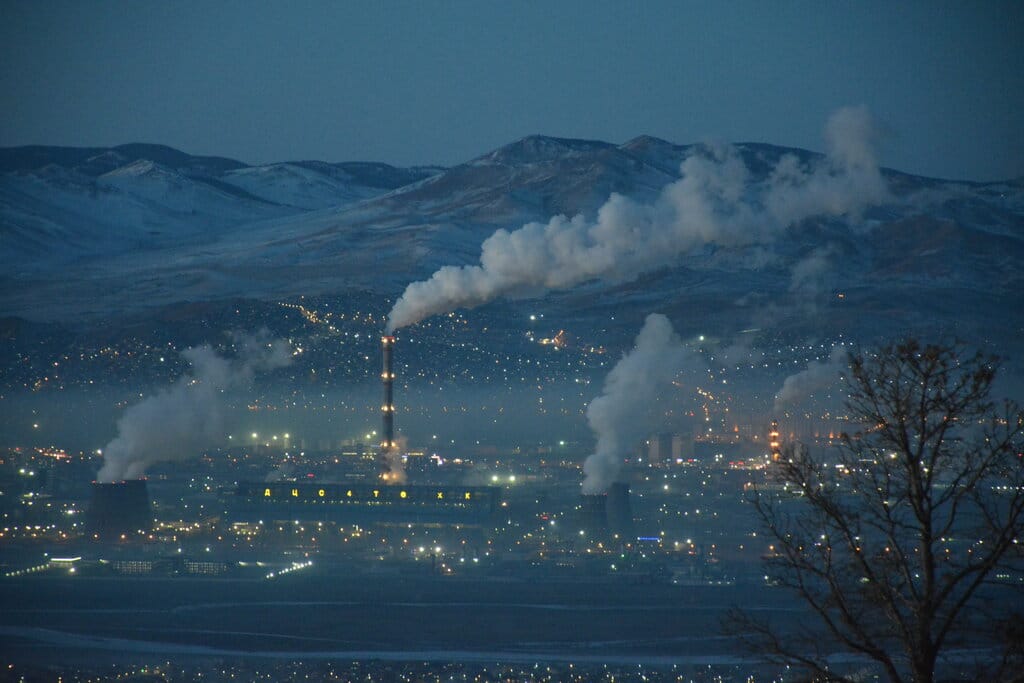The UN climate science panel has stated that man-made carbon dioxide levels need to fall by 45% by 2030 from 2010 levels, to have a good chance of limiting warming to 1.5°C and avoiding the most severe impacts of climate change. But the world has already heated up by 1.1°C and is on track for a warming of at least 3°C as emissions continue to rise, which would bring worsening weather and catastrophic sea level rise, making parts of the earth uninhabitable, forcing countries to pledge ambitious carbon emission targets mitigate the exacerbating climate crisis.
—
What are the Emission Targets Major Emitting Countries Set for 2030?
In 2019, the United States of America emitted 6.6 billion metric tons of greenhouse gases, out of which carbon dioxide accounted for 80%, making them the second largest producer of fossil fuel CO2 emissions, 14.5% of global emissions.
To combat climate change, the USA has set an economy-wide target of reducing its net greenhouse gas emissions by 50-52% below 2005 levels in 2030.
In addition, the US also considered sector-by-sector emission reduction pathways:
Electricity – To reach 100% carbon pollution-free electricity by 2035. Support rapid deployment of carbon pollution-free electricity generating resources, transmission, and energy storage. Also, support research and development of software and hardware to support a carbon pollution-free, reliable, and affordable electricity system.
Transportation – Policies that can contribute towards emission targets include tailpipe emissions and efficiency standards; incentives for zero emission personal vehicles; funding for charging infrastructure; public charging, and long-distance travel; research and development to support advances in very low carbon new-generation renewable fuels. Investment in a wider array of transportation infrastructure for transit, rail, biking, and pedestrian improvements.
Buildings – Ongoing government support for energy efficiency and efficient electric heating and cooking in buildings, wider use of health pumps and induction stoves, and adoption of modern energy codes for new buildings. Also, invest in new technologies to reduce emissions associated with construction.
Industry – Support research and development of very low- and zero-carbon industrial processes and products.
Agriculture and lands – Support scaling of climate smart agricultural practices, reforestation, rotational grazing, and nutrient management practices. Invest in forest protection and forest management and engage in intensive efforts to reduce the scope and intensity of wildfires, and to restore fire-damaged forest lands. Support nature based coastal resilience projects.
You might also like: Is Biden’s New Emissions Reduction Target Good Enough?
China is the largest polluter in terms of fossil fuel CO2 emissions in the world, emitting 10.17 billion tonnes in 2019, taking up 27.92% of global emissions.
During the Climate Ambition Summit, Xi Jinping announced their updated 2030 carbon target of reducing its carbon intensity by more than 65% from 2005 levels by 2030, as compared to their previous target of lowering it by 60-65%, meaning China would reach the peak of its emissions between 2025 and 2030.
They have also made commitments to boost their installed capacity of wind and solar power to more than 1,200 gigawatts by 2030, increase the share of non-fossil fuels in primary energy consumption to around 25%, as compared to the previous target of 20%, and increase forest stock volume by 6 billion cubic meters, previously 4.5 billion cubic meters.
However, no plans for halting new coal projects were mentioned during the speech.
In 2019, Russia emitted 1.68 billion tonnes of CO2 emissions, making it the fourth largest producer of fossil fuel emissions in the world.
The Russian Federation has set its limit of greenhouse gas emissions to 70% relative to the 1990 level, or 30% reduction emission targets, taking into account the maximum possible absorptive capacity of forests and other ecosystems and subject to sustainable and balanced socio-economic development of the Russian Federation.
In addition to the mitigation target, they also describe their national climate policies, target areas, and voluntary support for developing countries. According to their Nationally Determined Contribution (NDC), the Russian Federation’s efforts focus on fiscal measures to stimulate greenhouse gas reductions, increasing energy efficiency in all sectors, and developing use of non-fuel and renewable energy sources. Other measures are aimed at improving the quality of natural sinks and storage of greenhouse gases. The Russian Federation will also update its greenhouse gas emission standards in line with the international standards for quantifying carbon footprint.
In 2019, the United Kingdom emitted 454.8 million tonnes of carbon dioxide, 43.8% lower than they were in 1990. The UK is committing to reduce economy-wide greenhouse gas emissions by at least 68% by 2030, compared to 1990 levels.
The country will mobilise £12 billion of government investment to create and support up to 250,000 highly skilled green jobs in the UK, and unlock three times as much private sector investment by 2030
10 Point Plan for Green Industrial Revolution:
- Advancing offshore wind – By 2030, the UK plans to quadruple offshore wind capacity, backing new innovations to make most of this proven technology, aiming to produce 40GW of offshore wind.
- Driving the growth of low carbon hydrogen – The UK is aiming for 5GW of low carbon hydrogen production capacity by 2030.
- Delivering new and advanced nuclear power – Deploy the first small modular reactors and advanced modular reactor demonstrator in the UK by early 2030s.
- Accelerating the shift to zero emission vehicles – End the sale of new petrol and diesel cars and vans from 2030. Require all vehicles to have a significant zero emissions capability from 2030 and be 100% zero emissions from 2035.
- Green public transport, cycling, and walking – Invest in rail and bus services, and in measures to help pedestrians and cyclists.
- Jet zero and green ships – Invest in R&D to develop zero-emission aircraft and develop the infrastructure at airports and seaports.
- Greener buildings – Ensure that the public sector has reduced its direct emissions by 50% compared to a 2017 baseline by 2032. Build Future Homes Standards to be ‘zero-carbon ready’ and have 75-80% lower carbon dioxide emission than current standards.
- Investing in carbon capture, usage, and storage – Aim to capture and store 10 million tonnes of CO2 per year by 2030.
- Protecting our natural environment – Increasing the Green Recovery Challenge Fund to deliver over 100 nature projects. Protect 30% of UK land. Investment in flood defences across every region of England.
- Green finance and innovation – Raising total R&D investment to 2.4%of GDP by 2027. Bring down the cost of net zero transition, nurture the development of better products and business models, and influence consumer behaviour.
In 2019, greenhouse gas emissions in the European Union were 2.54 billion tonnes of CO2, out of which Germany, the 7th largest emitter in the world and the largest in the EU, emitted 701.96 million tonnes.
Combined, member states will deliver at least a 55% reduction in greenhouse gas emissions as compared to 1990 levels by 2030.
Under regulation, each EU member state has an emission target to reduce from 2005 levels by 2030:
Belgium 35%; Bulgaria 0%; Czech Republic 14%; Denmark 39%; Germany 38%; Estonia 13%; Ireland 30%; Greece 16%; Spain 26%; France 37%; Croatia 7%; Italy 33%; Cyprus 24%; Latvia 6%; Lithuania 9%; Luxembourg 40%; Hungary 7%; Malta 19%; Netherlands 36%; Austria 36%; Poland 7%; Portugal 17%; Romania 2%; Slovenia 15%; Slovakia 12%; Finland 39%; Sweden 40%.
EU Emissions Trading System – Strengthening cap on overall emissions with the aim to expand use of emission trading to more sectors.
Energy efficiency – Launch a renovation wave to improve housing quality and strengthen the role of eco-design standards.
Renewable energy – Revisit and review the biomass sustainability criteria and develop a new European terminology and certification system for all renewable and low-carbon fuels.
Road transport CO2 emissions – Strengthen the CO2 standards for cars and vans for 2030 and beyond and reflect on the phase-out date for internal combustion engines.
Agriculture, Land Use, Land Use Change and Forestry – Integrate approach to reduce emissions from agriculture, provide bio-based materials for our economy, protect and enhance the natural carbon sink and improve the resilience of forests and agriculture to climate change.
India, the third largest polluter in the world who emitted 2,597.4 million tonnes in 2019, has set emission targets reduce emissions by 33-35% by 2030 from 2005 levels.
India plans to achieve this by aiming to install 40% cumulative electric power capacity from non-fossil fuel-based energy resources by 2030 with the help of the transfer of technology and low-cost international finance included from the Green Climate Fund. This would also create an additional carbon sink equivalent to additional forest and tree cover by 2030.
With a potential of more than 100GW, a target of 60 GW of wind power installed capacity by 2022 has instead been set. There is also a solar expansion programme which seeks to enhance capacity to 100GW by 2022, which is to be scaled up further thereafter, with solar power projects, solar parks, canal top solar projects, and solar pumps for farmers currently in development. They are also promoting solarisation of all 55,000 petrol pumps across the country, out of which 3,135 have already been solarised.
Additionally, multiple programmes have also been initiated for promotion of cleaner and more efficient use, including biomass-based electricity generation, which is envisioned to increase biomass installed capacity to 10GW by 2022.
Japan, the fifth largest producer of fossil fuel emissions, emitted 1.11 billion tonnes of CO2 emissions and has vowed to reduce its greenhouse gas emissions by at least 46%by 2030 from its 2013 levels, up from its previous target of 26% However, it is still under pressure to set a 50% emission targets.
Some of their path to carbon neutrality include:
Automobiles and storage batteries – Electric and plug-in hybrid vehicles to account for 20-30% of new passenger car sales by 2030.
Carbon recycling – Reduce the costs of concrete and fuels that absorb carbon dioxide. Foster social implementation, through public procurement, deploying efforts globally. Eg. Reduce the price of carbon dioxide-absorbing concrete to the same level as existing products in 2030.
Offshore wind power – Plans for domestic roll out of offshore wind power. Attract the wind power industry to Japan while enhancing competitiveness of domestic suppliers and building a resilient supply chain.
Nuclear power innovations – Maintain stable supplies of carbon-free electricity and draw on nuclear power innovations to accommodate various societal needs, which include enhancing safety, reliability, efficiency, etc.
Shipping – Promote development of engines, fuel tanks, and other components of ships using liquefied natural gas (LNG), hydrogen, ammonia, and other gases as fuel which are essential for achieving the zero emission targets.
Infrastructure – Undertake a range of efforts to cut CO2 emissions from infrastructure, which include rolling out district heating and cooling systems that recover heat from sewage systems, switching to LED street lighting, installing renewable power plants, etc.
The major countries of the world have all pledged to have some reduction in their CO2 emissions to avoid catastrophic effects of climate change and limit warming. The next steps would be to reach net-zero by 2050.
Featured image by: Pxfuel


















